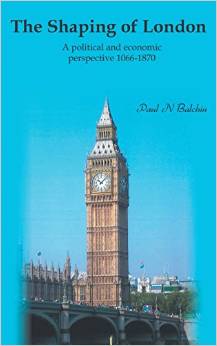This is a landmark historical account of the influence of nobility and landed gentry on the London architectural landscape between the 11th – 19th Centuries
More information: http://www.amazon.co.uk/Shaping-London-Political-Perspective-1066-1870/dp/1785070649
This book examines chronicles the impact of wars, dynastic struggles, demographic change and economic growth on the physical fabric of London, and although its findings are by no means scientific but implied, it should be clear to the reader that the development of great buildings of London such as castles and palaces, ecclesiastical buildings, imposing public and commercial buildings, and sumptuous townhouses, as well as public open spaces such as squares and parks did not arise by accident, but coincided with prevailing periods of peace and economic opportunity. It is within the context of politics and economics, and with a wide range of examples, that the book traces the evolution of architectural style in London, England from Romanesque to Gothic, from Tudor to Jacobean, from Classical to Baroque, and from Palladian to Neo-Classical culminating in the Victorian battle between the Neo-Baroque and Neo-Classical.
It is argued by Dr Paul Balchin that, over the whole period covered by this book, kings, governments, bankers, merchants and industrialists invested heavily in developing London to create a sense of majesty, awe, economic power and national pride; and aristocratic dynasties and landed gentry – often from elsewhere in England – commissioned sumptuous properties in the capital as a means of expressing their wealth and position in society; while the church (often with royal assistance) built imposing edifices to extend their influence. Thus as an outcome of numerous motives, the more notable buildings and public places of London and their spatial dispersal helped determine the shape and areal extent of the metropolis, enabling it to become the world\’s largest city in the 19th century.
About the Author:
Dr Paul Balchin is former Reader in Urban Economics at the University of Greenwich. Published widely, he is author and co-author of several books on different aspects of the building environment, most recently Urban Development in Renaissance Italy (John Wiley & Sons Ltd, 2008).
Excerpt from the book:
“It could almost be said that in London, the twentieth century began in 1870 with its population soaring ahead from that year. It was by then that the capital had witnessed the substantial development of the railways and underground rail system, was being rapidly built-up both in the public and private sectors and often through the use of new building materials such as iron and glass, and had by far the most extensive ocean docks in Britain enabling it to fully exploit the opportunities of maritime trade with the rest of the world, opportunities that had grown throughout much of the nineteenth century because of the growth of the British Empire and the absence of any major European war since 1815.
Therefore to understand why London has achieved pre-eminence in Britain in terms of its population and as a global economic player in the early twenty-first century, it is not only necessary to look back to the end of the nineteenth century, but also to the whole period from the Norman Conquest to the first half of Victoria’s reign. Thus, in reviewing the dramatic political history of England since 1066 and – to an extent – its concurrent economic history, this book suggests why and how London grew from a minor off-shore settlement on the edge of Europe with around 10,000 inhabitants in 1100 to a world city with a population of 3.8 million by 1870 – a prelude to its global importance today.”
The Shaping of London: A Political and Economic Perspective 1066-1870 is available in hardback from Amazon at:
http://www.amazon.co.uk/Shaping-London-Political-Perspective-1066-1870/dp/1785070649
or from Barnes & Noble at:
www.barnesandnoble.com/w/the-shaping-of-london-paul-n-balchin/1120394046
Press/Media Contact Details:
New Generation Publishing
Tel. 01234 712 064
E-mail: info@newgeneration-publishing.com


